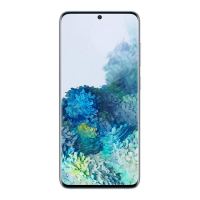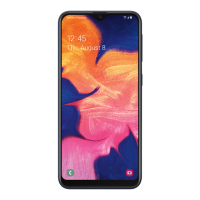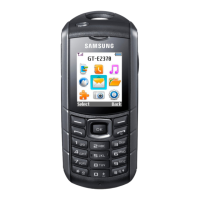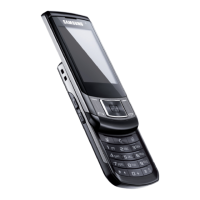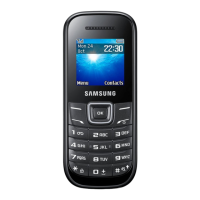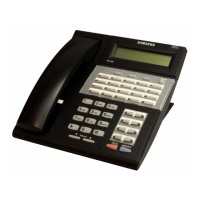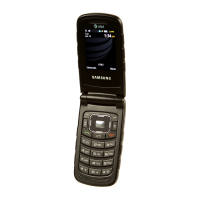Do you have a question about the Samsung Galaxy J3 Eclipse and is the answer not in the manual?
Learn how to set up your device for the first time.
This section helps you to assemble your device.
Instructions for inserting a SIM card into the device.
Steps to insert and secure the device battery.
Steps to place and secure the back cover onto the device.
How to connect the USB cable and charge the device.
Instructions on how to power the device on and off.
How to secure and access the device using screen lock features.
Procedure to restart the device if it becomes unresponsive.
Guiding through the initial device setup process after assembly.
Setting up your Google Account for device features.
Understanding FRP to prevent unauthorized access after reset.
Creating a Samsung account for device content and apps.
Transferring photos, videos, apps, and more using Smart Switch.
Overview of the device's home screen layout and elements.
How to access and view notifications and quick settings.
Adding, removing, and reordering screens and widgets.
Creating, removing, and moving app shortcuts on the home screen.
Creating, naming, coloring, and managing app folders.
Basic touchscreen gestures: tap, double-tap, touch and hold, swipe.
Entering text using the QWERTY keyboard and special keys.
Symbols, voice input, clipboard, emoticons, and keyboard settings.
Customizing keyboard types, predictive text, and settings.
Entering text by speaking using voice input feature.
Enabling and using the split screen view for apps.
How to turn on Emergency mode for battery conservation.
Available apps and features in Emergency mode: flashlight, alarm, call.
Accessing, launching, uninstalling, and hiding apps.
Finding and installing new applications from the Google Play Store.
How to remove downloaded apps; preloaded apps cannot be uninstalled.
Managing downloaded and preloaded applications.
Capturing photos using front or rear camera, adjusting brightness, effects.
Recording high-quality videos, pausing, resuming, and stopping.
Adjusting camera settings like picture size, video size, and save options.
Adding new contacts with name, photo, and other information.
Composing new emails, adding recipients, subject, and attachments.
Browsing, viewing, and managing pictures and videos.
Browsing the internet, managing tabs, bookmarks, and address data.
Sending and receiving email via Google's web-based email service.
Searching the internet, apps, and device contents.
Finding location, getting directions, and location-based information.
Finding and downloading new apps, music, books, and games.
Creating and sending messages with attachments and emoticons.
Sending emergency messages with location to contacts.
Receiving wireless emergency alerts (CMAS/PLAN).
Making calls using the dialer or from contacts.
Answering incoming calls via swipe or tap.
Adding numbers to the block list to prevent calls and messages.
Dialing emergency numbers regardless of service status.
Making emergency calls even when the device is locked.
Protecting the device from digital threats and unauthorized access.
Conserving battery power during emergencies by disabling apps/functions.
Resetting device to factory defaults (except security, language, accounts).
Resetting Wi-Fi, Mobile data, and Bluetooth settings.
Resetting device to factory defaults, erasing all data.
Checking for and installing available software updates for the device.
Scanning for and connecting to available Wi-Fi networks.
Establishing trusted connections by pairing with Bluetooth devices.
Preventing apps from using data in the background to save data.
Enabling or disabling mobile data usage on the phone.
Limiting mobile data usage and setting data usage limits.
Allowing other devices to use the phone's internet connection.
Selecting how location is determined: High accuracy, Battery saving, Phone only.
Switching between Sound, Vibrate, and Mute modes.
Adjusting ringtone, media, notification, and system volumes.
Configuring sounds for notifications, messages, and calendar events.
Blocking notifications and alerts during specific times.
Blocking notifications for specific apps or all apps.
Adjusting screen brightness for surroundings or battery conservation.
Customizing the home screen with shortcuts, widgets, folders, and wallpapers.
Viewing details of battery power usage by item.
Extending battery life by selecting power saving modes.
Viewing device memory and usage, managing storage.
Securing the device with Swipe, Pattern, PIN, or Password.
Automatically receiving security policy updates and sending reports.
Adding email, social networking, and other account types.
Enabling backup of information to your Google account.
Accessibility features for visual assistance: dark screen, high contrast, magnification.
Accessibility features for hearing: flash notification, mute sounds, hearing aids, subtitles.
Accessibility features for dexterity: assistant menu, touch delay, interaction control.
